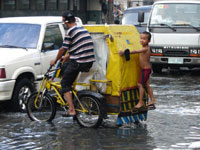Big waves in Philippines force more than 5,000 to flee from coast
Big waves hit the western Philippines provinces. More than 5,000 people escaped from the area, some of them falsely thinking there was a tsunami.

There were no immediate reports of casualties from the onslaught of waves that sporadically battered coastal villages from the country's mountainous north to the southern island of Jolo from late Tuesday to early Wednesday.
The waves also created flash floods by pushing sea water into low-lying areas.
Along the western coast of the main northern Luzon island, which was jolted by a magnitude-6 earthquake about noon Tuesday, more than 5,400 people fled to safety and government emergency shelters after the waves swamped their communities, said Armando Duque, head of the regional Office of Civil Defense.
In the coastal town of Bolinao in northern Pangasinan province, many villagers feared that a tsunami struck because of the earthquake, but authorities immediately explained through local radio stations that the waves were generated by stormy weather out at sea, Duque said.
Many were puzzled by the waves because Typhoon Mitag, which lashed the northern Philippines on Monday, had weakened into a storm then blew out of the country toward southern Japan , causing weather to improve by Tuesday.
"Many thought that there may have been a tsunami so authorities had to tell them that the waves were caused by the weather disturbances," Duque told The Associated Press by telephone.
In the southern coastal village of Sinunuc, dozens of families fled after waves hit their wooden huts on stilts, sweeping several away and injuring some residents.
"The waves suddenly hit our hut and brought down a wall. We ran for our lives," said resident Elmer Abubakar, adding that his and nearby huts were destroyed.
Knee-high floodwaters brought by the waves receded from a key seaside boulevard, leaving trash, corals and other debris. Some inter-island ferries and cargo boats did not dock in a nearby pier fearing more waves, officials said.
Meanwhile, the death toll from Mitag rose to 19 on Wednesday with one injured and eight missing, disaster officials said. Three people died and six more were missing after two boats capsized in Taal Lake, south of Manila, late Tuesday, officials said.
Chief government forecaster Nathaniel Cruz said the waves generated by a second storm, Hagibis, in the South China Sea took some time to reach western coastal areas. Some were pushed by lingering strong winds and slammed ashore during high tide, he said.
Defense Secretary Gilbert Teodoro urged local officials to continue monitoring their coastal areas and carry out "pre-emptive evacuations" if there was a resurgence in big waves.
Subscribe to Pravda.Ru Telegram channel, Facebook, RSS!





